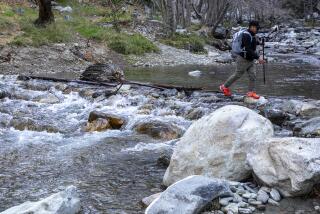Shuttle Buses Promote the Sound of Silence in Zion National Park
- Share via
The classic hike from the floor of Utah’s Zion Canyon to the rimrock Observation Point still offers everything it always has: a sampling of slick-rock country, passage through a narrow canyon and stunning views. But now hikers will find more.
More quietude.
Count me as an enthusiastic supporter of Zion National Park’s shuttle system, started in 2000.
During the peak season of March to October, visitors must ride buses into the heart of Zion Canyon, leaving their cars behind.
Eliminating most private vehicles has improved visits to the park immeasurably. No parking hassles. No jumping in and out of a car to reach a viewpoint or trail head. And no noise.
OK, you occasionally hear a bus. But gone are the other engines echoing up the canyon walls to vista points such as Angels Landing.
“The trail to Observation Point has long been my favorite hike in the park,” said Marcel Rodriguez, 79, a park interpreter at the visitor center. “Now, without the traffic down below, it’s even better.”
Though temperatures rise well above 100, summer is still a popular time for this week’s featured route, the challenging trek to Observation Point.
As Rodriguez said, “It packs a lot of Zion into four miles of trail.” I couldn’t agree more. Just remember to take lots of water and sunscreen and to start early in the morning, so you can avoid the midafternoon heat.
Directions to the trail head: The shuttle system has two components. Springdale Loop buses take visitors from five locations in the nearby town of Springdale to the Zion visitor center at the park’s south entrance. From there, the Zion Canyon Loop shuttle continues to eight stops inside the park, including the Zion Museum and various viewpoints.
Pickups are every six to 30 minutes depending on the shuttle and the time of day. Operating hours vary by shuttle; for details call (435) 772-0312 or go to www.nps.gov/zion/ShuttleSystem.htm for a sample (though not necessarily current) schedule.
Another option is to skip the Springdale shuttle altogether. Drive to the Zion visitor center, park, then hop aboard the Zion Canyon Loop shuttle.
The hike starts at the Weeping Rock stop.
The hike: Partly paved Observation Point Trail switchbacks up rock walls, offering better views with each gain in elevation. Look down and see the alcove that harbors Weeping Rock.
After climbing half a mile, you will spot a signed half-mile spur trail that leads to Hidden Canyon. If you want to try this optional side trip, grasp the chain handrails along the narrow ledge.
With a 1,000-foot drop-off, it’s a cliffhanger. The route continues up a trailless wash between towering walls of sandstone at the bottom of Hidden Canyon.
Back at the main trail, hike half a mile farther to the mouth of Echo Canyon, a narrow chasm with awesome walls of fluted stone spiked with pines. Switchbacks rise to a junction with East Rim Trail at the two-mile mark.
Continue toward Observation Point. The trail is wide, but you’ll encounter more 1,000-foot drop-offs in places. The path traverses white cliffs, then reaches a plateau dotted with pinyon pine and juniper. At the 3 1/2-mile mark, you’ll pass a junction with East Mesa Trail; stick to Observation Point Trail as it turns south.
A fairly level hike on a sandy path leads to the edge of the plateau and Observation Point. Use a park map to identify the great stone cathedrals and ramparts around you.
*
For more of John McKinney’s tips, visit www.thetrailmaster.com.
More to Read
Sign up for The Wild
We’ll help you find the best places to hike, bike and run, as well as the perfect silent spots for meditation and yoga.
You may occasionally receive promotional content from the Los Angeles Times.






